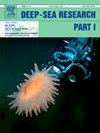Coral and float-derived observations of flow around SG_áan K_ínghlas-Bowie Seamount in the Northeast Pacific: revisiting the Taylor cone
IF 2.3
3区 地球科学
Q2 OCEANOGRAPHY
Deep-Sea Research Part I-Oceanographic Research Papers
Pub Date : 2025-04-04
DOI:10.1016/j.dsr.2025.104499
引用次数: 0
Abstract
Seamounts are oases of life within the deep sea. Recruitment mechanisms to these isolated systems, where benthic larvae spend weeks or months in the pelagic, remain a mystery. Persistent closed circulation patterns ('Taylor cones') are proposed to increase local retention around these underwater mountains, but the idea remains controversial. Some coral species may help us understand this puzzle. Cold-water corals, such as Primnoa pacifica and Parastenella spp., grow slowly, orienting their fan perpendicular to, and curved towards, the mean-flow direction. We took advantage of these long-term natural current meters, using a combination of benthic imagery, sea-surface height, Argo trajectory, hydrographic, and reanalysis model data to examine flow around Sáan ínghlas-Bowie Seamount (S-B) in the Northeast Pacific. We found that corals living on the seafloor on all sides of the seamount experienced a north to south flow (opposite to regional circulation), showing no evidence of a persistent closed circulation. We suggest that a combination of remotely generated internal tides breaking on the plateau and steering/rectification of local tides below 500m could cause these strong coherent bottom currents. Finally, we also observed transient clockwise circulation around the seamount when Haida Eddies became trapped. Eddies provide a regular mechanism for larval and food transport from the coast to S-B. Once trapped, the closed clockwise circulation lasts months and likely aids in local retention and self-recruitment. Our findings reveal the dynamic nature of flow over seamount-like features and the importance of understanding this complexity in the broader context of marine conservation.

东北太平洋SG_áan K_ínghlas-Bowie海山附近珊瑚和浮物衍生的流动观测:重新访问泰勒锥
海山是深海中的生命绿洲。底栖幼虫在这些与世隔绝的系统中要在水层中度过数周或数月的时间,其招募机制仍然是一个谜。有人提出,持续封闭的环流模式("泰勒锥")可增加这些水下山脉周围的局部潴留,但这一观点仍存在争议。一些珊瑚物种可能有助于我们理解这一谜团。冷水珊瑚,如太平洋珊瑚(Primnoa pacifica)和副珊瑚(Parastenella spp.),生长缓慢,其扇形垂直于平均水流方向,并向平均水流方向弯曲。我们利用这些长期的自然海流测量数据,结合底栖生物图像、海面高度、阿尔戈轨迹、水文地理和再分析模型数据,对东北太平洋 SG_áan K_ínghlas-Bowie 海山(SK_-B)周围的海流进行了研究。我们发现,生活在海山四面海底的珊瑚经历了自北向南的流动(与区域环流相反),没有证据表明存在持续的闭合环流。我们认为,高原上遥控产生的内部潮汐断裂和 500 米以下当地潮汐的转向/修正相结合,可能会导致这些强烈的连贯底流。最后,当海达涡被困时,我们还观察到海山周围的瞬时顺时针环流。海达涡为幼虫和食物从海岸向 SK_-B 的运输提供了一个常规机制。一旦被困,封闭的顺时针环流会持续数月,很可能有助于当地的保留和自我招募。我们的研究结果揭示了海山地貌上水流的动态性质,以及在更广泛的海洋保护背景下了解这种复杂性的重要性。
本文章由计算机程序翻译,如有差异,请以英文原文为准。
求助全文
约1分钟内获得全文
求助全文
来源期刊
CiteScore
4.60
自引率
4.20%
发文量
144
审稿时长
18.3 weeks
期刊介绍:
Deep-Sea Research Part I: Oceanographic Research Papers is devoted to the publication of the results of original scientific research, including theoretical work of evident oceanographic applicability; and the solution of instrumental or methodological problems with evidence of successful use. The journal is distinguished by its interdisciplinary nature and its breadth, covering the geological, physical, chemical and biological aspects of the ocean and its boundaries with the sea floor and the atmosphere. In addition to regular "Research Papers" and "Instruments and Methods" papers, briefer communications may be published as "Notes". Supplemental matter, such as extensive data tables or graphs and multimedia content, may be published as electronic appendices.

 求助内容:
求助内容: 应助结果提醒方式:
应助结果提醒方式:


